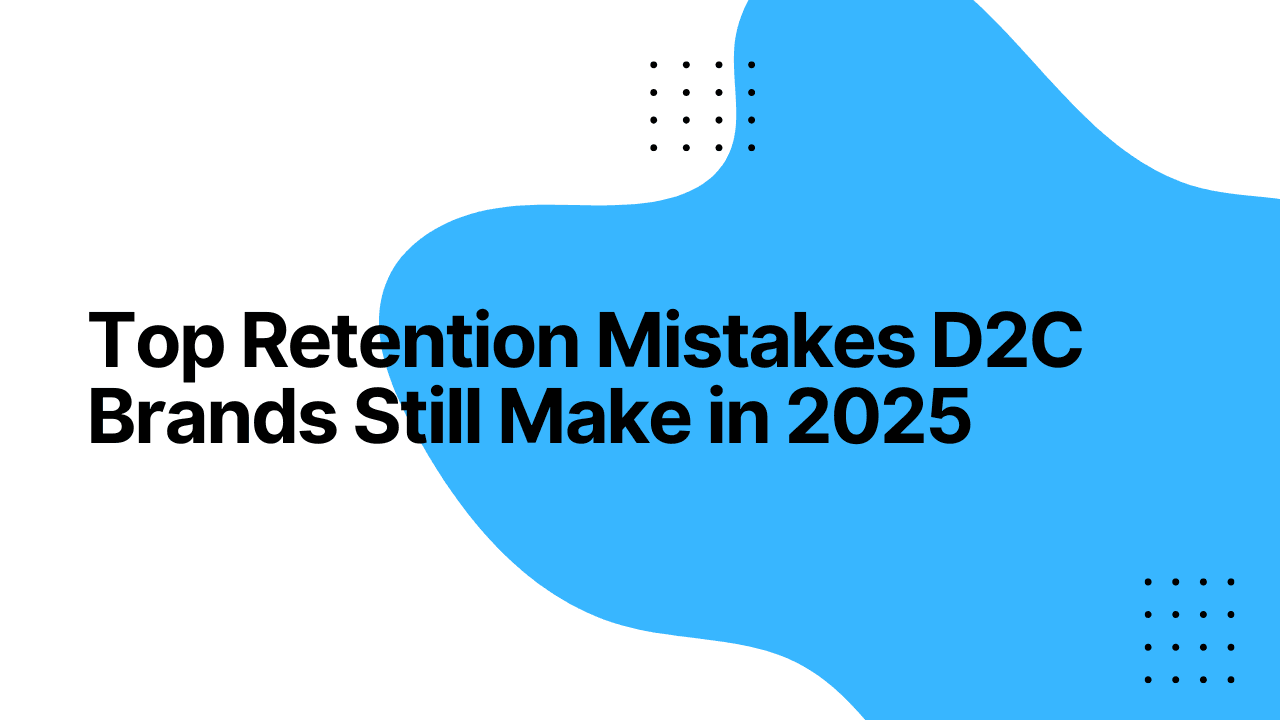Top Retention Mistakes D2C Brands Still Make in 2025

Introduction
It’s 2025, and D2C brands are more sophisticated than ever. They use AI for personalization, run sleek loyalty programs, and obsess over customer data.
Yet, customer retention remains a blind spot for many.
Acquisition still eats up most of the budget, while repeat purchases, loyalty, and CLTV are left underdeveloped—or worse, assumed to happen “naturally.”
If your customers are churning or ghosting after their first order, you might be making one of these all-too-common retention mistakes.
Let’s break down the biggest errors D2C brands are still making in 2025—and how you can avoid them.
1. Prioritizing Acquisition Over Retention
Many brands still treat retention as an afterthought, pouring 80% of the budget into ads and influencers to acquire new users.
The problem?
Acquisition costs are rising, and a one-time purchase rarely pays for itself. Without a solid retention plan, you're constantly refilling a leaky bucket.
Fix it:
- Shift your focus from ROAS to customer lifetime value (CLTV)
- Invest in post-purchase journeys, loyalty programs, and email/SMS nurturing
- Use tools like Ziovy to build long-term relationships, not one-off sales
2. No Segmentation of Customers
Treating every customer the same is a huge mistake. Not all customers have the same intent, value, or behavior.
Example: Someone who bought a trial-sized item once shouldn't get the same emails as a VIP repeat buyer.
Fix it:
- Segment by RFM (Recency, Frequency, Monetary value)
- Personalize content based on purchase behavior, engagement, and preferences
- Create loyalty tiers to recognize and reward top customers
3. Forgetting the Post-Purchase Experience
D2C brands often pour effort into the pre-purchase funnel, then go silent once the transaction is complete.
But that’s when retention begins.
Fix it:
- Use thank-you emails, unboxing experiences, and helpful onboarding
- Send timely follow-ups like usage tips, refill reminders, and cross-sell offers
- Ask for feedback early and often
4. Cold, Transactional Communication
Automated emails are good—but robotic, generic messaging kills connection. If your customers only hear from you when you're promoting a sale, don’t be surprised if they tune out.
Fix it:
- Infuse personality, empathy, and storytelling into your comms
- Highlight user-generated content, community stories, or behind-the-scenes brand moments
- Use personalization beyond just “Hi [First Name]”
5. Loyalty Programs Without Real Value
Having a points-based program isn’t enough anymore. If rewards are hard to earn or feel meaningless, customers won’t stick around.
Fix it:
- Make rewards instantly valuable (e.g., birthday perks, welcome offers, fast access to VIP tiers)
- Gamify progression with clear visual feedback
- Offer experiential rewards, early access, or community perks—not just discounts
6. Ignoring Customer Feedback
If you’re not collecting, analyzing, and acting on customer feedback, you’re flying blind.
Fix it:
- Send post-purchase surveys, NPS forms, or ask for reviews
- Use feedback loops to improve products and service
- Let customers know you’ve acted on their input—it builds trust
7. Not Measuring Retention Metrics Properly
Vanity metrics like email open rates or follower counts don’t equal retention.
Fix it:
Track:
- Repeat purchase rate
- Customer lifetime value (CLTV)
- Churn rate
- Customer retention cost (CRC)
- Time between purchases
Use these insights to refine your lifecycle marketing strategy.
Conclusion: Retention Is a Strategy, Not a Tactic
Retention is not something you “add on” to your marketing. It should be baked into every touchpoint, every experience, every decision.
The D2C brands winning in 2025 are those that turn customers into communities, and transactions into relationships.
Avoid these mistakes, and you’ll not only increase your repeat purchase rate—you’ll build a brand that lasts.
Expore More
1. 7 Proven Strategies to Increase Your Customer Lifetime Value
2. Customer Retention and Tiered Loyalty Programs: A Powerful Duo for D2C Brands. 3. How to Increase Customer Retention and Build Lasting Brand Loyalty 4. Beyond Discounts: 5 Proven Strategies to Turn One-Time Buyers into Regular Customers 5. Loyalty Programs vs. Subscription Models: Which One Builds Better Customer Retention?